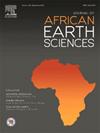埃及西北部沙漠Badr El-Din 2油田Abu Roash组白垩系裂谷后混合硅-塑料-碳酸盐储层岩石类型及石油成因
IF 2.2
4区 地球科学
Q2 GEOSCIENCES, MULTIDISCIPLINARY
引用次数: 0
摘要
硅-塑-碳酸盐混合沉积层序是油气勘探的远景目标。这些层序通常具有粒间孔隙和次生孔隙的储集相,并可能受到层内烃源岩有机相的积极充注。在西部沙漠滨海裂谷盆地,上白垩统Abu Roash组裂谷后序列沉积于浅海至深海环境。然而,迄今为止,abu Roash内部石油系统的存在并没有得到充分的记录。本研究将有机地球化学数据与详细的岩石物理分析相结合,阐明了BED-2油田Abu Roash组混合硅-碳酸盐相的油气来源,并对储层岩石类型进行了表征。地球化学数据表明,Abu Roash原油主要来自II/III型混合干酪根,海相有机质贡献较大。原油呈规则的C29 >甾烷分布模式;C28祝辞C27,表明源自海相和陆相混合烃源岩。此外,Abu Roash原油与邻近盆地的侏罗系和白垩系原油具有明显的负相关关系,但与Abu Roash泥岩沥青提取物具有较强的地球化学亲和性。沉积相分析表明,Abu Roash混合硅屑-碳酸盐相沉积于浅海环境中,以潮汐通道砂岩、泻湖碳酸盐岩、上滨面、潮汐入口和潮坪相交替沉积为特征,下滨面至近海泥岩覆盖。岩石物理分析确定了5种不同的RRTs,其中最高的储层质量(RRT1)与潮汐通道砂岩有关。相比之下,泻湖碳酸盐岩表现出高度非均质储层性质,对流体流动起到微导管和挡板的作用。值得注意的是,大约60%的储层流体流动能力归因于RRT1的潮汐通道相,而下岸面至近海泥岩则是有效的封闭岩石。这项研究的结果证实了研究区域内存在abu Roash石油系统,从而为更广泛的西北沙漠省的油气勘探开辟了新的机会。此外,本研究结果强调了全球范围内具有优质储层流动单元、烃源岩有机相和有效封闭岩的碳酸盐-硅屑混合沉积体系的广泛勘探意义。本文章由计算机程序翻译,如有差异,请以英文原文为准。
Reservoir rock typing and origin of oil in the Cretaceous post-rift mixed siliciclastic-carbonate of Abu Roash Formation, Badr El-Din 2 field, north Western Desert, Egypt
Mixed siliciclastic-carbonate depositional sequences represent highly prospective targets for hydrocarbon exploration. These sequences commonly host reservoir facies characterized by both intergranular and secondary porosity, and they may be actively charged by intra-formational source rock organofacies. In the coastal rift basins of the Western Desert, the Upper Cretaceous post-rift succession of the Abu Roash Formation was deposited in environments ranging from shallow to deep marine settings. However, the existence of an intra-Abu Roash petroleum system has not been well-documented to date. This study integrates organic geochemical data with detailed petrophysical analysis to elucidate the origin of the hydrocarbons and to characterize the reservoir rock types (RRTs) within the mixed siliciclastic-carbonate facies of the Abu Roash Formation in wells from the BED-2 Field. Geochemical data reveal that the Abu Roash oil was sourced from a mixed Type II/III kerogen, with a greater contribution from marine organic matter. The oil exhibits a regular sterane distribution pattern of C29 > C28 > C27, indicative of derivation from a mixed marine and terrestrial source rock. Moreover, the Abu Roash oil shows a clear negative correlation with Jurassic and Cretaceous oil families from adjacent basins but demonstrates a strong geochemical affinity with bitumen extracts from Abu Roash mudstones.
Depositional facies analysis indicates that the Abu Roash mixed siliciclastic-carbonate facies were deposited in a shallow marine setting, characterized by alternating tidal channel sandstones, lagoonal carbonates, upper shoreface, tidal inlet, and tidal flat facies, capped by lower shoreface to offshore mudstones. Petrophysical analysis identifies five distinct RRTs, with the highest reservoir quality (RRT1) associated with tidal channel sandstones. In contrast, the lagoonal carbonates exhibit highly heterogeneous reservoir properties, acting as micro-conduits and baffles to fluid flow. Notably, approximately 60 % of the reservoir's fluid flow capacity is attributed to the tidal channel facies of RRT1, while lower shoreface to offshore mudstones serve as effective sealing rocks. The findings of this study confirm the presence of an intra-Abu Roash petroleum system in the study area, thereby opening new opportunities for hydrocarbon exploration across the broader north Western Desert province. Moreover, the results of this study underscore the broader exploration significance of mixed carbonate–siliciclastic depositional systems globally hosting high-quality reservoir flow units, source rock organofacies, and effective seal rocks.
求助全文
通过发布文献求助,成功后即可免费获取论文全文。
去求助
来源期刊

Journal of African Earth Sciences
地学-地球科学综合
CiteScore
4.70
自引率
4.30%
发文量
240
审稿时长
12 months
期刊介绍:
The Journal of African Earth Sciences sees itself as the prime geological journal for all aspects of the Earth Sciences about the African plate. Papers dealing with peripheral areas are welcome if they demonstrate a tight link with Africa.
The Journal publishes high quality, peer-reviewed scientific papers. It is devoted primarily to research papers but short communications relating to new developments of broad interest, reviews and book reviews will also be considered. Papers must have international appeal and should present work of more regional than local significance and dealing with well identified and justified scientific questions. Specialised technical papers, analytical or exploration reports must be avoided. Papers on applied geology should preferably be linked to such core disciplines and must be addressed to a more general geoscientific audience.
 求助内容:
求助内容: 应助结果提醒方式:
应助结果提醒方式:


